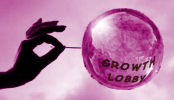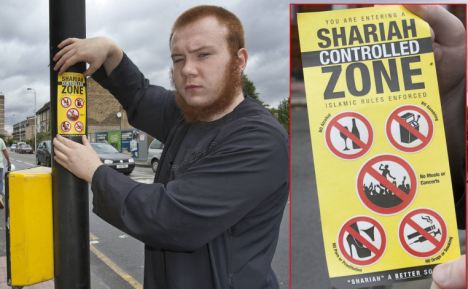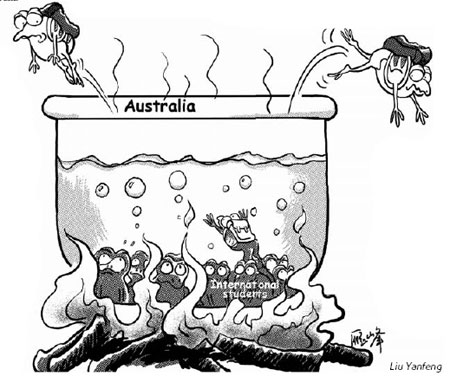IT was reported as if Sydney should cry and Melbourne should crow, when the truth is all of us should panic. So in just 27 years, Melbourne would have 5.7 million people and stagnant Sydney could go cry us a harbour.
Cry, because the BIS Shrapnel report, commissioned by Australia’s shark-fanged property developers, presented this finding as a kick in Sydney’s manhood. The report’s title said it all: Going Nowhere.
But that “nowhere” may still be better than the somewhere to which Melbourne is now hurtling – and the rest of this clueless country with it, thanks to an immigration policy that’s now wildly out of control.
Fact is, this report is yet more proof that not only is our population growing too fast for our creaking cities, but – more dangerously – too fast for us to turn immigrants into Australians.
I say that because here’s what none of yesterday’s reports on the study noted.
Just five years ago, the Australian Bureau of Statistics predicted Melbourne wouldn’t reach even five million people before 2051, and Sydney then would have only 5.6 million.
Just five years later and we’re told to expect not five million by 2051, but 5.7 million – and 14 years earlier.
That’s more than 1.5 million extra people by 2037 in a city that’s been on water restrictions for eight years.
But as with Melbourne and Sydney, so with the rest of this country that’s lost its brakes.
Our flailing Prime Minister last year said he supported Australia reaching a population of 36 million by 2050 – even though no state government is ready for even a fraction of such growth.
But even that huge target is being overwhelmed by a flood of immigrants unleashed by the Rudd Government.
Nearly 300,000 people, in net figures, were allowed in last year, driving a growth rate that would give us not 36 million Australians by mid-century but 42 million, or twice what we have now.
Yes – we could still give all these extra people a home, but only if we give up many of our new green taboos.
We would need to return to the kind of Australia my own parents found when they moved from Europe to Adelaide about 50 years ago – an Australia that still dared to build coal-fired power plants, dams, the Snowy hydro scheme and even a nuclear plant at Lucas Heights. A country that built stuff.
But now? Coal is evil, dams are such a sin that no capital city has built one since 1983, and nuclear power is banned, banned, banned.
Even more insane, most state governments are so against violating holy Nature with houses that they’ve managed the trick of creating a land shortage in the least populated continent on earth, outside Antarctica.
Our will to develop has weakened, almost suicidally so. But more dangerous is the weakening of our will to turn immigrants into Australians.
I must not exaggerate. The vast majority of immigrants settle in willingly and brilliantly.
But for too long we’ve blindly assumed that their merging with the rest of us would happen inevitably, without any effort from government.
Scared to seem racist, we refused to notice increasing signs of strain and separation, and haven’t dared have the debate Britain is now belatedly holding.
Compare: Britain, with three times our population takes in just two thirds as many immigrants, yet its Labour Government now admits even this is so high that it brings “new worries”, while the Conservatives are calling for “an explicit annual limit”.
What worries both parties is that Britain’s much lower immigration is still divisive – a fear no mainstream politician here yet dares voice.
It’s true that high immigration can (usually) make us richer. It can make our restaurants more interesting. It can bring to this country people brighter than the average oi-oi-oi bogan. It allows us to rush in trained people we forgot to train for ourselves.
But it inevitably also brings in people who feel less connection to this country, and thus less duty to it. It can be like the difference between renters and owners. Who looks after the place better?
These changes are so great that by 2025 more than half of us will have been born overseas, or will, like me, have at least one parent born abroad.
This alone is a challenge, since many studies in many countries – including one here by the Australian National University’s Dr Andrew Leigh – show that the more ethnically diverse a place, the less trust people have in each other.
THEY’RE not sure they share the same values, and, indeed, often don’t. They’re not even sure they speak the same language, and not just literally.
And so we get a Pru Goward, once the federal Sex Discrimination Commissioner and now a NSW Liberal MP, improbably complaining this month that Sudanese men are victims of Australian values, since their wives are given welfare income and are told they have “the right to walk away” from bad marriages and wife-bashers.
“We were not told our ways would not be respected,” one man told Goward, who seemed strangely unwilling to tell the man to fit in with the egalitarian values she once trumpeted or go home.
This illustrates how unprepared we are now to welcome people from very different cultures without sacrificing our own values to theirs.
The cultural confidence that immigrants of my parents’ generation met has almost melted away.
Those arriving now come to a sorry-saying country where it’s long been fashionable to promote multiculturalism and attack the national symbols and stories we rely on to inspire affection for this land.
Take the Anzac Day weekend just gone. Ray Martin on Channel 9 chose this very weekend, meant to unite us, to stage a divisive debate on 60 Minutes on a flag he claims is too British. The usual crop of books were also published to denounce the celebrations as a conservative plot to make the young bloodthirsty, and Age columnist Catherine Deveny tweeted to readers that Anzac Day celebrated murderers, rapists and racists.
So no one can be surprised in such a climate that up to a dozen youths of Middle Eastern appearance spent Anzac Day eve trashing the war memorial at Sydney’s Arncliffe RSL Club and snapping the flagpoles.
What respect do they owe to Australian symbols that aren’t even respected by born-here Leftists?
Are Muslim immigrants even permitted by their faith to acknowledge some Australian symbols? Already defendants in court have refused to stand for the judge, saying Islam forbade such submission.
We might put our faith in Australia’s fabled ability to melt such differences, but that magic is weakening.
Intermarriage rates were high among post-war immigrants from Western European countries such as Germany and Holland, then less so among Greeks and Italians. They’re now even lower among newer immigrants from the Middle East and Asia.
TIME may well change that, yet some ethnic divisions seem to be hardening, not blurring.
Crime rates among the Vietnamese-born are still very high, decades later, and the rise of ethnic gangs among the recently arrived is troubling.
The NSW police’s biggest specialist unit is its Middle Eastern Crime Squad, with 120 members, and jail rates in Australia of the Lebanese-born are higher than for any other ethnic group except Tongans, Samoans, Romanians, Vietnamese and now the Sudanese.
More worrying, NSW police say they’re even more likely to arrest the children and grandchildren of the Lebanese-born.
Or consider some of the crime stories reported over just the past week.
In Perth, a Sudanese man was killed in a brawl between Africans and Afghans. In Adelaide, police said they were looking for four African women who bashed a woman so badly in a nightclub that she lost an eye. In Melbourne last weekend, police were attacked by up to 50 men, and arrested eight of Sudanese background.
Or take the recent bashings and murders of Indians and tourists that have won us international condemnation as racists.
In almost every case, the most high-profile attacks were allegedly committed by immigrants and members of ethnic gangs.
Agreed, we can overcome all this, as we’ve done before. We can turn strangers into fellow Australians, just as we can build the homes, power stations and dams they’ll need, too.
But the question is: do we have the will to change our ways? Do we have the will to build and the will to create an Australia that commands the loyalty and love of those who come here?
I fear the answer.

